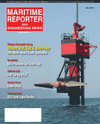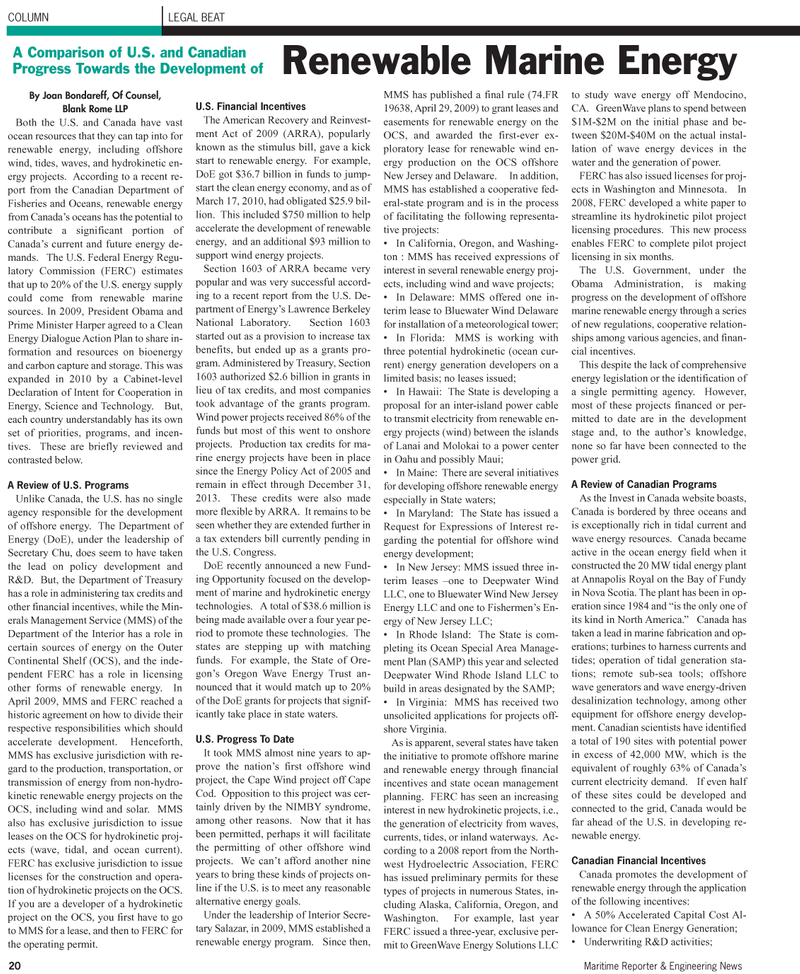
Page 20: of Maritime Reporter Magazine (July 2010)
Satellite Communication Edition
Read this page in Pdf, Flash or Html5 edition of July 2010 Maritime Reporter Magazine
By Joan Bondareff, Of Counsel,
Blank Rome LLP
Both the U.S. and Canada have vast ocean resources that they can tap into for renewable energy, including offshore wind, tides, waves, and hydrokinetic en- ergy projects. According to a recent re- port from the Canadian Department of
Fisheries and Oceans, renewable energy from Canada’s oceans has the potential to contribute a significant portion of
Canada’s current and future energy de- mands. The U.S. Federal Energy Regu- latory Commission (FERC) estimates that up to 20% of the U.S. energy supply could come from renewable marine sources. In 2009, President Obama and
Prime Minister Harper agreed to a Clean
Energy Dialogue Action Plan to share in- formation and resources on bioenergy and carbon capture and storage. This was expanded in 2010 by a Cabinet-level
Declaration of Intent for Cooperation in
Energy, Science and Technology. But, each country understandably has its own set of priorities, programs, and incen- tives. These are briefly reviewed and contrasted below.
A Review of U.S. Programs
Unlike Canada, the U.S. has no single agency responsible for the development of offshore energy. The Department of
Energy (DoE), under the leadership of
Secretary Chu, does seem to have taken the lead on policy development and
R&D. But, the Department of Treasury has a role in administering tax credits and other financial incentives, while the Min- erals Management Service (MMS) of the
Department of the Interior has a role in certain sources of energy on the Outer
Continental Shelf (OCS), and the inde- pendent FERC has a role in licensing other forms of renewable energy. In
April 2009, MMS and FERC reached a historic agreement on how to divide their respective responsibilities which should accelerate development. Henceforth,
MMS has exclusive jurisdiction with re- gard to the production, transportation, or transmission of energy from non-hydro- kinetic renewable energy projects on the
OCS, including wind and solar. MMS also has exclusive jurisdiction to issue leases on the OCS for hydrokinetic proj- ects (wave, tidal, and ocean current).
FERC has exclusive jurisdiction to issue licenses for the construction and opera- tion of hydrokinetic projects on the OCS.
If you are a developer of a hydrokinetic project on the OCS, you first have to go to MMS for a lease, and then to FERC for the operating permit.
U.S. Financial Incentives
The American Recovery and Reinvest- ment Act of 2009 (ARRA), popularly known as the stimulus bill, gave a kick start to renewable energy. For example,
DoE got $36.7 billion in funds to jump- start the clean energy economy, and as of
March 17, 2010, had obligated $25.9 bil- lion. This included $750 million to help accelerate the development of renewable energy, and an additional $93 million to support wind energy projects.
Section 1603 of ARRA became very popular and was very successful accord- ing to a recent report from the U.S. De- partment of Energy’s Lawrence Berkeley
National Laboratory. Section 1603 started out as a provision to increase tax benefits, but ended up as a grants pro- gram. Administered by Treasury, Section 1603 authorized $2.6 billion in grants in lieu of tax credits, and most companies took advantage of the grants program.
Wind power projects received 86% of the funds but most of this went to onshore projects. Production tax credits for ma- rine energy projects have been in place since the Energy Policy Act of 2005 and remain in effect through December 31, 2013. These credits were also made more flexible by ARRA. It remains to be seen whether they are extended further in a tax extenders bill currently pending in the U.S. Congress.
DoE recently announced a new Fund- ing Opportunity focused on the develop- ment of marine and hydrokinetic energy technologies. A total of $38.6 million is being made available over a four year pe- riod to promote these technologies. The states are stepping up with matching funds. For example, the State of Ore- gon’s Oregon Wave Energy Trust an- nounced that it would match up to 20% of the DoE grants for projects that signif- icantly take place in state waters.
U.S. Progress To Date
It took MMS almost nine years to ap- prove the nation’s first offshore wind project, the Cape Wind project off Cape
Cod. Opposition to this project was cer- tainly driven by the NIMBY syndrome, among other reasons. Now that it has been permitted, perhaps it will facilitate the permitting of other offshore wind projects. We can’t afford another nine years to bring these kinds of projects on- line if the U.S. is to meet any reasonable alternative energy goals.
Under the leadership of Interior Secre- tary Salazar, in 2009, MMS established a renewable energy program. Since then,
MMS has published a final rule (74.FR 19638, April 29, 2009) to grant leases and easements for renewable energy on the
OCS, and awarded the first-ever ex- ploratory lease for renewable wind en- ergy production on the OCS offshore
New Jersey and Delaware. In addition,
MMS has established a cooperative fed- eral-state program and is in the process of facilitating the following representa- tive projects: • In California, Oregon, and Washing- ton : MMS has received expressions of interest in several renewable energy proj- ects, including wind and wave projects; • In Delaware: MMS offered one in- terim lease to Bluewater Wind Delaware for installation of a meteorological tower; • In Florida: MMS is working with three potential hydrokinetic (ocean cur- rent) energy generation developers on a limited basis; no leases issued; • In Hawaii: The State is developing a proposal for an inter-island power cable to transmit electricity from renewable en- ergy projects (wind) between the islands of Lanai and Molokai to a power center in Oahu and possibly Maui; • In Maine: There are several initiatives for developing offshore renewable energy especially in State waters; • In Maryland: The State has issued a
Request for Expressions of Interest re- garding the potential for offshore wind energy development; • In New Jersey: MMS issued three in- terim leases –one to Deepwater Wind
LLC, one to Bluewater Wind New Jersey
Energy LLC and one to Fishermen’s En- ergy of New Jersey LLC; • In Rhode Island: The State is com- pleting its Ocean Special Area Manage- ment Plan (SAMP) this year and selected
Deepwater Wind Rhode Island LLC to build in areas designated by the SAMP; • In Virginia: MMS has received two unsolicited applications for projects off- shore Virginia.
As is apparent, several states have taken the initiative to promote offshore marine and renewable energy through financial incentives and state ocean management planning. FERC has seen an increasing interest in new hydrokinetic projects, i.e., the generation of electricity from waves, currents, tides, or inland waterways. Ac- cording to a 2008 report from the North- west Hydroelectric Association, FERC has issued preliminary permits for these types of projects in numerous States, in- cluding Alaska, California, Oregon, and
Washington. For example, last year
FERC issued a three-year, exclusive per- mit to GreenWave Energy Solutions LLC to study wave energy off Mendocino,
CA. GreenWave plans to spend between $1M-$2M on the initial phase and be- tween $20M-$40M on the actual instal- lation of wave energy devices in the water and the generation of power.
FERC has also issued licenses for proj- ects in Washington and Minnesota. In 2008, FERC developed a white paper to streamline its hydrokinetic pilot project licensing procedures. This new process enables FERC to complete pilot project licensing in six months.
The U.S. Government, under the
Obama Administration, is making progress on the development of offshore marine renewable energy through a series of new regulations, cooperative relation- ships among various agencies, and finan- cial incentives.
This despite the lack of comprehensive energy legislation or the identification of a single permitting agency. However, most of these projects financed or per- mitted to date are in the development stage and, to the author’s knowledge, none so far have been connected to the power grid.
A Review of Canadian Programs
As the Invest in Canada website boasts,
Canada is bordered by three oceans and is exceptionally rich in tidal current and wave energy resources. Canada became active in the ocean energy field when it constructed the 20 MW tidal energy plant at Annapolis Royal on the Bay of Fundy in Nova Scotia. The plant has been in op- eration since 1984 and “is the only one of its kind in North America.” Canada has taken a lead in marine fabrication and op- erations; turbines to harness currents and tides; operation of tidal generation sta- tions; remote sub-sea tools; offshore wave generators and wave energy-driven desalinization technology, among other equipment for offshore energy develop- ment. Canadian scientists have identified a total of 190 sites with potential power in excess of 42,000 MW, which is the equivalent of roughly 63% of Canada’s current electricity demand. If even half of these sites could be developed and connected to the grid, Canada would be far ahead of the U.S. in developing re- newable energy.
Canadian Financial Incentives
Canada promotes the development of renewable energy through the application of the following incentives: • A 50% Accelerated Capital Cost Al- lowance for Clean Energy Generation; • Underwriting R&D activities; 20 Maritime Reporter & Engineering News
COLUMN LEGAL BEAT
Renewable Marine Energy
A Comparison of U.S. and Canadian
Progress Towards the Development of

 19
19

 21
21
